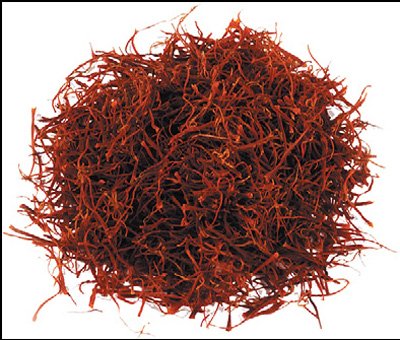Saffron
Ayurvedic Medicine

Saffron
Saffron (E), Kesar (H):
In India saffron is cultivated in Kashmir and when it is flowering it fills the fields with a fantastic red glow. It is a small perennial growing to about 20cm with violet leaves and each flower producing three stamens. It takes about 160 flowers to produce 1g of dried saffron. Think gynaecology, blood, heart and reproduction when using saffron.
Gynaecology It has a nourishing effect on rasa dhatu and an invigorating action on the blood. This can help to bring on delayed menses and increase the flow. It is also used in dysmenorrhoea. It is a wonderful tonic herb that nourishes the deeper tissues. Use with any fertility problems with s´ukra dhatu deficiency or obstruction. Anaemia Its affinity for the blood and rakta dhatu is complemented by its ability to increase haemoglobin levels. This connection with the blood helps alleviate other symptoms that can arise from anaemia such as heart conditions with pain and liver congestion. Heart Its positive effects on rasa and rakta dhatu actively encourages blood flow through the circulatory system. It is indicated in angina and cardiac congestion. Reproduction It is a renowned aphrodisiac herb that can help treat impotence and low libido. It rejuvenates the s´ukra dhatu and nourishes the reproductive tissues. Nerves Its nourishing effects subtly feed the nervous and reproductive tissues indicating its use for debilitating and degenerative diseases. Use when there is vata disturbance, depression, majja dhatu deficiency and general nervous debility. Urine It goes directly to mutravahasrotas and a cold infusion is beneficial for painful urination. External As a paste it helps to alleviate discoloration of the skin, acne and eczema. It can also be applied to the forehead to clear headaches caused by vata and cold.
 Sarpagandha
Sarpagandha Haritaki
Haritaki Safed Musali
Safed Musali Mustard Seed
Mustard Seed Ephedra
Ephedra Vasa
Vasa Fennel
Fennel Ajwain
Ajwain Bhallataka
Bhallataka Cinnamon
Cinnamon Lemon And Lime
Lemon And Lime Dhattura
Dhattura Test your English Language
Test your English Language  Know Tie Knots
Know Tie Knots Benefits of Honeydew
Benefits of Honeydew The Most Romantic Train Journeys
The Most Romantic Train Journeys Tips to get ready for Study Abroad
Tips to get ready for Study Abroad Benefits of Avocado
Benefits of Avocado Romantic Valentines Date Ideas
Romantic Valentines Date Ideas




